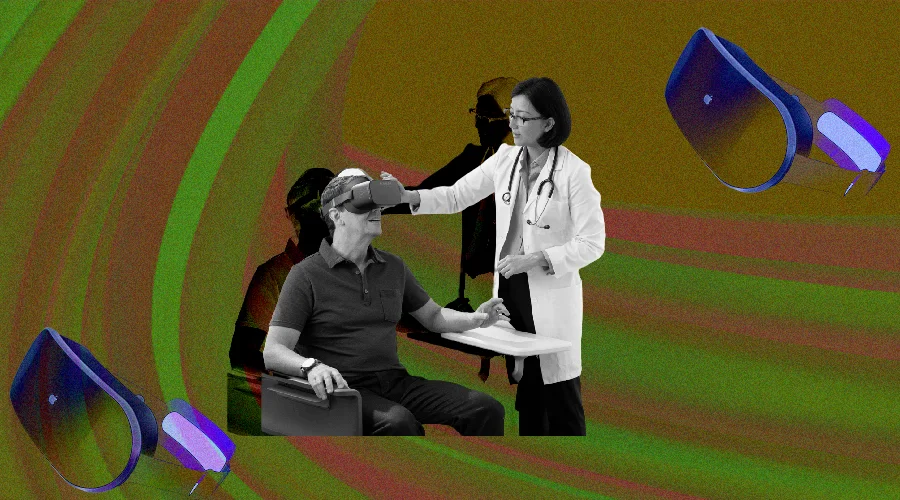
AUGMENTED/VIRTUAL REALITY LATEST NEWS
by Sayantani Sanyal March 14, 2022
Virtual reality is one of the most advanced technologies making huge strides in the healthcare sector
Virtual reality solutions allow both healthcare professionals and patients to interact with simulated environments designed for medical education, pain management, and rehabilitation. Most of us are quite aware of the use of VR in gaming, metaverse, and in other advanced and emerging tech domains. But the contributions of virtual reality in medicine and healthcare are quite remarkable too. In fact, healthcare is among the top industries that remain as the leading adopters of VR technology, for quite a long time. According to reports by Accenture, 82% of healthcare professionals agree that virtual reality creates a convenient way of accessing and learning information for medical students and practicing healthcare professionals. The existing infrastructure of VR applications in healthcare depends on their distinct use cases in the industry. Besides this, new studies have revealed that virtual reality has made great strides in pain management, and could effectively become the next kind of pain killer that we use!
Researchers interested in exploring how technology can treat patients with chronic pain have found that when combined with cognitive behavioural therapy, virtual reality has successfully decreased pain intensity. Furthermore, for decades, technology has been able to help people overcome phobias and anxiety disorders. One of its first applications for pain management was developed in the mid-90s to distract burn victims from the excruciating pain while changing their wounds. The VR environment, SnowWorld, was developed to ease the pain of severe burns. After being immersed in the VR simulation, a patient can either become a part of an interactive gamified experience or be transferred to a highly realistic environment with a soothing atmosphere and audio stimulation that helps put their minds at ease.
Understanding Virtual Reality’s Expansion to Chronic Pain Management
Virtual reality is a state-of-art, technologically advanced system that allows users to be transported into a virtual world. Users are engaged in a fully immersive VR experience with the help of a combination of technologies, including a head-mounted display, headphones with sound/music, noise reduction, and other advanced tech gadgets for manipulation and navigation of the virtual environment. Traditionally, VR was usually recognized for its entertainment properties. But, over the past decade, its application has been expanded to a variety of clinical areas, including pain management, physical rehabilitation, and the treatment of psychiatric disorders. It has been frequently used for studying medical settings as a means to attenuate pain perception, anxiety, and general distress during painful medical procedures, such as wound care, chemotherapy, dental procedures, and other routine medical procedures.
While some experts speculate that VR creates a non-medicated form of analgesia by changing the activity of the body’s pain modulation system, some others postulate that VR serves as a pain distraction by reducing the perception of pain by absorbing and diverting attention away from the pain. But the use of VR in pain management also has its own side effects. Several patients have reported experiencing ‘cybersickness’, the feeling of dizziness, and nausea when the patient is wearing a VR headset. Moreover, they have also experienced side effects leading to blurred vision, eye strain, and headaches.
‘Digiceuticals’, one of a few approved digital therapeutic devices, is intended for at-home self-use and consists of a VR headset, controller, and a ‘breathing amplifier’ attached to the headset that directs a patient’s breath towards the headset’s microphone to help them in deep breathing exercises.
Several companies have entered the VR field to discover the next generation of systems that go beyond being a distraction therapy and instead focus the brain away from pain. These companies are focused on working on an entirely new type of VR therapy, which they have dubbed as VR neuropsychological therapy. This new approach is quite different from the traditional VR therapy that aims to change how the brain perceives pain and create a lasting reduction in pain.
Bottom line
This explosive interest in VR technology for medical and therapeutic purposes is definitely not going to slow down, at least in the near future. There are several researchers and companies dedicated to making these initiatives a success to make sure healthcare providers can offer the best services to the patients.
You should also check out the following articles:
- VR BUYING GUIDE AND THE BEST VR HEADSET FOR 2022
- A meta market opportunity: The metaverse could soon be worth $1 trillion
- Facebook wants to build a metaverse. Microsoft is creating something even more ambitious.
- How to succeed in the virtual reality world of tomorrow?
- Books you must read about virtual reality
- Best New Augmented Reality Books To Read In 2021
- US$ 4.7 Billion- The global augmented reality gaming market
- The smart glasses revolution is about to get real
- Consumer Brands Reinventing Marketing in the Metaverse
- Imagine Making Money in Rec Room
- The biggest AR and VR predictions of 2022
- Apple hired Meta's AR communications lead ahead of the 2022 launch of the headset.
- Who Will Be in Charge of the Metaverse?
- The Kingdom of Abraham: The first Jewish metaverse
- Gen Z are planning to spend thousands on cryptocurrency, NFTs and metaverse
- According to Goldman Sachs, the metaverse must run on blockchain
- What You Can Create With a Small Piece of Land in the Metaverse
- How To Buy Land In The Metaverse?


